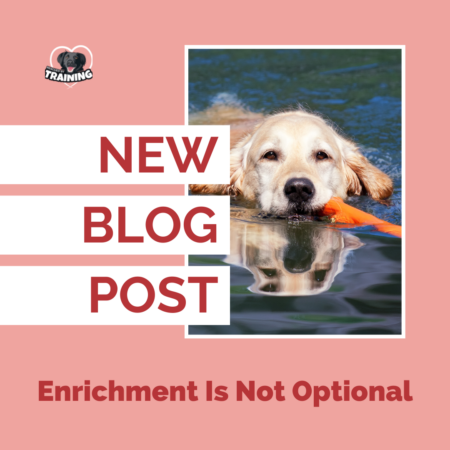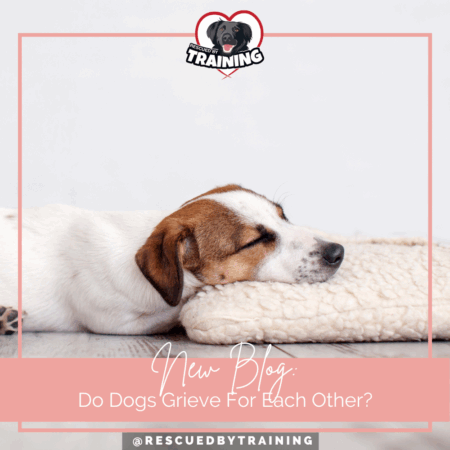Enrichment isn’t optional. It’s not a nice, extra thing we should be doing for our animals – it’s a critical part of their well-being, health and happiness. Enrichment is ensuring we are meeting all of a species needs. This is not optional.
And because of that, enrichment is one thing I chat with clients about often. Dogs come pre-wired with many skills like sniffing, chewing, dissecting and scavenging that many domesticated dogs don’t have a good outlet for. Family dogs often find themselves with endless hours of lounging around and not having an ability to use these skills, which can lead to boredom, destruction, frustration (for owners and dogs!) and decreased quality of life. But let’s be clear, the point of enrichment is not to tire your dog out – it is to providing outlets for natural behaviors. This not only improves quality of life but is essential to their overall health, mental and physical and often has a happy side effect of tiring them out. But exhaustion is not the end goal of enrichment.
Think about it like this, if you’re working on your computer all day slogging through a detailed spreadsheet and troubleshooting, at the end of the day, you’re exhausted. Your brain is tired and that makes you tired. Dogs are the same. When we give them problem solving skills or activities, that can be hard work and can make then tired.
Dog-dog play is one of the best physical and enrichment activities because it’s not just physical exercise like running, but it’s giving dogs an opportunity to use social skills and hone body language skills to figure out which dogs want to play, which ones don’t and how to interact with different dogs. It’s like when we walk into a big party and we scan the room to figure out who we want to talk to and engage with and who we want to avoid.
So what do I mean when I talk about “species needs being met”? Well, there’s the obvious things we think about like food, shelter and water but what about other physical needs?
- Age appropriate, safe medical/vet care
- Nutritionally appropriate food/treats
- Age and physically appropriate exercise
- Grooming/hygiene, including bathing, nails, teeth, ears, anal glands or other breed specific needs (skin folds, for example in rolly polly dogs)
- Overall safety in their environment (no aversive training, rough handling, forced grooming or vet care, not running loose near traffic, no access to poisonous items like plants, mushrooms, medications)
What about their psychological needs?
- Ability to feel safe (not forced into situations)
- Ability to move away from triggers the animal finds scary
- Allowed to investigate their environment
- Access to a safe area where they will not be disturbed
- Living in an environment where they are not stressed just by existing in that space
And then finally, having opportunities for species or breed specific behaviors. We cannot ignore genetics that are constantly at play in our animals. Even if the terrier you have wasn’t specifically bred to hunt and kill small critters or the border collie mix you have isn’t a farm dog, there’s always a little bit of genetics at play and these animals will need an outlet for those breed specific needs. Most dogs have not been bred to be solely companions or lap dogs. Most dogs have some purpose or job they were bred to do, even if that’s far back in their lineage. And when we have mixed breeds, even “designer” or purpose bred mixes, like doodles, there’s always going to be variation in what traits pop out in that particular mix that we cannot control for. What are some examples of instinctual dog behaviors?
- Chewing
- Digging
- Sniffing
- Barking
- Chasing
- Scavenging
- Hunting
- Swimming
- Running/herding
- Licking
- Dissecting/shredding
- Interacting with their own species
- Sleeping
We need to be sure we giving our dogs an opportunity for all of these in the course of normal life for our dogs. Of course they don’t need all of these every single day (except sleeping!) but access to a diversity of activities is important. But if your dog is barking or chewing a lot, what are they trying to tell us?
There are many ways to increase enrichment but one of the easiest ways is to take the simple act of feeding our dog and turn it into an activity that improves their quality of life using food toys, easy training and scavenging games.
Enrichment can also help fearful dogs build some confidence by getting them to interact with with environment and can be a better option than trying to hand feed a fearful dog. But no dog should have to work for all their food, especially fearful dogs. We don’t want to force a dog to engage with us just because they’re hungry. There should always be some “free” food offered if the dog wants to “vote with their feet” and choose not to engage with us.
View my Enrichment YouTube playlist here for more DIY enrichment ideas and enrichment toys in action!
Happy training!
![]()




